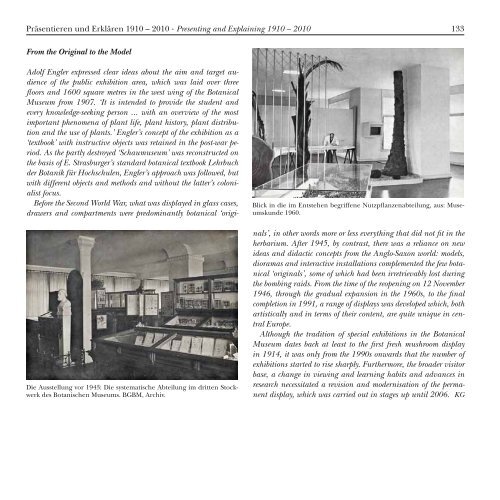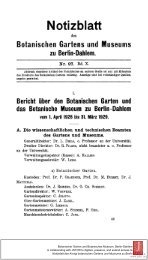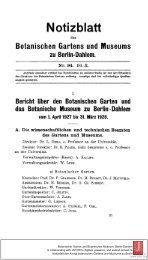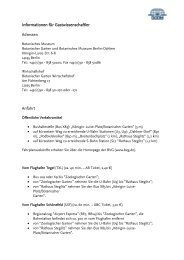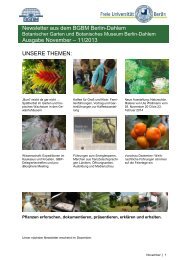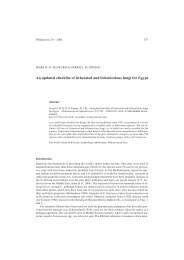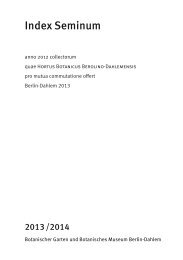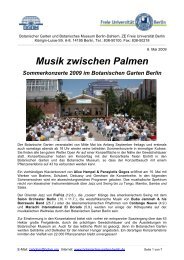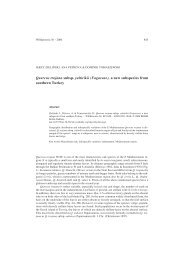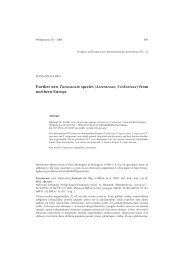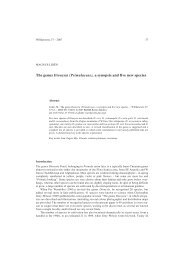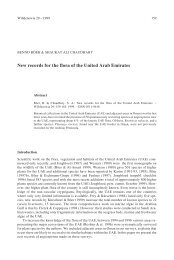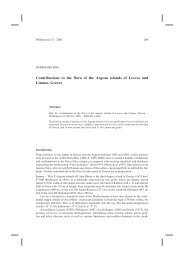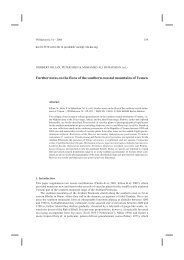Ausstellungskatalog - Botanischer Garten und Botanisches Museum ...
Ausstellungskatalog - Botanischer Garten und Botanisches Museum ...
Ausstellungskatalog - Botanischer Garten und Botanisches Museum ...
Sie wollen auch ein ePaper? Erhöhen Sie die Reichweite Ihrer Titel.
YUMPU macht aus Druck-PDFs automatisch weboptimierte ePaper, die Google liebt.
Präsentieren <strong>und</strong> Erklären 1910 – 2010 · Presenting and Explaining 1910 – 2010<br />
From the Original to the Model<br />
Adolf Engler expressed clear ideas about the aim and target audience<br />
of the public exhibition area, which was laid over three<br />
floors and 1600 square metres in the west wing of the Botanical<br />
<strong>Museum</strong> from 1907. ‘It is intended to provide the student and<br />
every knowledge-seeking person ... with an overview of the most<br />
important phenomena of plant life, plant history, plant distribution<br />
and the use of plants.’ Engler’s concept of the exhibition as a<br />
‘textbook’ with instructive objects was retained in the post-war period.<br />
As the partly destroyed ‘Schaumuseum’ was reconstructed on<br />
the basis of E. Strasburger’s standard botanical textbook Lehrbuch<br />
der Botanik für Hochschulen, Engler’s approach was followed, but<br />
with different objects and methods and without the latter’s colonialist<br />
focus.<br />
Before the Second World War, what was displayed in glass cases,<br />
drawers and compartments were predominantly botanical ‘origi-<br />
Die Ausstellung vor 1943: Die systematische Abteilung im dritten Stockwerk<br />
des Botanischen <strong>Museum</strong>s. BGBM, Archiv.<br />
133<br />
Blick in die im Entstehen begriffene Nutzpflanzenabteilung, aus: <strong>Museum</strong>sk<strong>und</strong>e<br />
1960.<br />
nals’, in other words more or less everything that did not fit in the<br />
herbarium. After 1945, by contrast, there was a reliance on new<br />
ideas and didactic concepts from the Anglo-Saxon world: models,<br />
dioramas and interactive installations complemented the few botanical<br />
‘originals’, some of which had been irretrievably lost during<br />
the bombing raids. From the time of the reopening on 12 November<br />
1946, through the gradual expansion in the 1960s, to the final<br />
completion in 1991, a range of displays was developed which, both<br />
artistically and in terms of their content, are quite unique in central<br />
Europe.<br />
Although the tradition of special exhibitions in the Botanical<br />
<strong>Museum</strong> dates back at least to the first fresh mushroom display<br />
in 1914, it was only from the 1990s onwards that the number of<br />
exhibitions started to rise sharply. Furthermore, the broader visitor<br />
base, a change in viewing and learning habits and advances in<br />
research necessitated a revision and modernisation of the permanent<br />
display, which was carried out in stages up until 2006. KG


